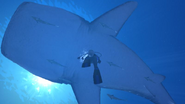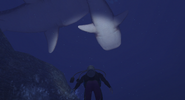← Tiger SharkEndless Ocean Creatures
Endless Ocean 2 CreaturesPelagic Thresher →
Basking Shark →
The Whale Shark (Rhincodon typus) is a large species of shark found in Endless Ocean and Endless Ocean 2.
It is best known as the largest species of shark, and largest fish overall, in the world. Despite this size, it is not dangerous to humans - it only eats plankton and tiny fish.
In-Game[]
Marine Encyclopedia[]
Endless Ocean[]
Description[]
"Whale sharks are the largest fish in the world. In addition to their size, their massive heads, wide mouths, and three prominent side ridges make them easy to identify. Whale sharks also have a pair each of dorsal and pectoral fins. Their bodies are gray and white, with a speckled pattern that is unique to each fish. These gentle creatures can be seen year-round near Mo'ia Atoll.
Their mouths contain a vast multitude of small teeth. When they feed, plankton and other tiny fish are pulled inside. The water is then expelled, leaving only the food behind. Instead of an air bladder, these fish have extra-oily livers to give them more buoyancy. They usually live about 300 feet below the surface (though they can dive to great depths) and are known to cover vast areas during their lifetimes.
Whale sharks were thought to be external egg layers, but recently a female shark was pregnant with about 300 pups, leading scientists to conclude that they are in fact ovoviviparous (which means their eggs hatch inside the body). The captured whale shark was relatively young and only 30 feet long. It is possible that fully grown adults could produce far more offspring."
Endless Ocean 2[]
Description[]
"This is the largest fish in the world, identified by the many white specks scattered across its blue back. Its mouth is especially large and filled with a huge number of small teeth. It feeds exclusively on small fish and plankton in the seawater it inhales. It has no air bladder, but obtains buoyancy by storing oil in its liver."
[ How Are They Born? ][]
"It was once thought that the whale shark was oviparous, meaning that it laid eggs. But 300 individual eggshells and embryos were found in the womb of a captured whale shark, and it is now believed that they are ovoviviparous, meaning that eggs are incubated inside the parent.
The captured female was 10m long so it is possible that bigger females may produce even more offspring."
Introductory Dialogue[]
Endless Ocean[]
Katherine: "Look! It's a whale shark! I wonder if it travels in and out of the atoll? This is our chance to check it out. Come on!"
[...]
"That fish looks big enough to grab. Why don't you follow it and research its migration route? The current is really strong, but... If you hang on, you might be able to keep going. Be careful! If you let go, it could be bad news."
Endless Ocean 2[]
Gatama Atoll specimen[]
"This creature is a whale shark. It is the biggest fish in the world and most divers would just love to encounter one. It is so popular, it could be called the star of Gatama Atoll. It is a very affable creature, why not try to interact with it?"
Zahhab Region specimen[]
"The whale shark is the biggest fish in the world. The largest recorded sighting was a 14m whale shark, but this, this clearly exceeds even that. You must take a picture of it! There are still many large and rare animals inhabiting the seas that we have yet to meet. It just adds to the wonder of the ocean, does it not?"
Location[]
Endless Ocean[]
One specimen is introduced via cutscene upon approaching Mo'ia Atoll at a certain point in the story, and the player must ride it in order to access the Underwater Ruins of Mo'ia Atoll due to the abnormal currents preventing the player from swimming there on their own. From then on, the same individual can be seen circling the main structure of the ruins rather close to the surface. At night, a second individual can sometimes be seen in the area, a little smaller than the first - potentially a younger specimen.
They can also been seen seasonally in multiple places: one appears in Coral Forest during spring, another patrols Rock Bluff in autumn at night, and there's also one at Entryway Slope.
Endless Ocean 2[]
One whale shark can be found around Gatama's Navel in Gatama Atoll, patrolling the map during both the day and especially during the night, where it also swims into the Atoll Gate. A bigger one can be found near Mushroom Rock in the Zahhab Region, Red Sea. This makes it the only rideable creature in the game to regularly appear on more than one map.
Behavior[]
Whale sharks are are solitary creatures that are often accompanied by remoras and other small fish. The individual in the Zahhab Region is followed around by pilotfish and golden trevallies alongside the remoras.
Their favor can be earned in the first game by petting and feeding them, and the player can unlock their trivia information in the second game by taking a picture of one of them.
Gallery[]
Videos[]
Notes[]
- This is one of Jean-Eric's favorite creatures, though only the whale shark in the Zahhab Region is, as it counts as his favorite after its cutscene.
- The individual at Mushroom Rock in the second game is much larger than any of the other whale sharks the player had seen thus far. They first see this large individual on a quest for a certain type of seaweed Hayako Sakurai requested them to find; when it appears, Jean-Eric freaks out a bit and says that the player should take a picture to record the moment.
Real-Life Information[]
- True to the in-game description, the whale shark is indeed the largest fish in the world[1]. The in-game length is accurate, too - adults tend to average at about 39 feet (12 meters) long[2]. The larger ones can reportedly reach up to 59 feet (18 meters)[3]. The very largest recorded individual was 66 feet (20 meters) long[4].
- Male whale sharks reach maturity at the age when they're about 26 to 30 feet (8 to 9 meters) long[5]. The maturity of females, however, can't be determined by the same method.
- Though whale sharks are huge, they're harmless to humans. The most dangerous part of them is their tail - being too close to a whale shark's tail while it's swimming may get a diver smacked out of the way and result in injury[6].
- Both in-game descriptions make accurate note of the fact that the whale shark is ovoviviparous (oh-voh-vy-VIH-puh-russ), which means that the eggs hatch inside of the mother's body before they are born[7]. The only pregnant female specimen ever found was caught off of the coast of Taiwan and was about 30 feet (10 meters) long, with more than 300 pups incubating inside her body[8][9]. She was considered a sort of "megamama supreme" by reporting scientists[10][11].
- The basking shark and whale shark, along with the megamouth shark, are the only three known plankton-eating shark species (in the image to the right, top-to-bottom)[12][13]. This means that all three of them filter water through their mouths to scoop plankton and small fish out of the water, rather than actively pursuing prey or scavenging like other sharks.
- The whale shark is an endangered species[16][17]. Threats to its survival include the fact that it is targeted by anglers due to the high value of its fins for shark-fin soup - one pectoral fin can net the seller as much as 20,000 dollars[10]. Their livers are also incredibly oily (as the descriptions from both games state), and this shark-liver oil is also a highly-valued commodity[18][19].
- The first game correctly says that whale sharks are known to travel great distances during their lifetimes. Over a period of 37 months, one whale was recorded migrating 8077.8 miles (13,000 kilometers)[20].
- The white speckles scattered across the back of every whale shark are in a unique pattern for each of them. Thus, the particular arrangement of speckles can be used as an identification tool, like a human fingerprint[17]. In this way, the white speckles of a whale shark are similar to the scars of a Risso's dolphin or the saddle patch of an orca. However, it is unknown what survival purpose, if any, the pattern on the back of every whale shark serves[7].
- A whale shark appears on the box art for Endless Ocean Luminous.
[]
Red Sea Bream
• Asian Sheepshead Wrasse
• Golden Trevally
• Giant Trevally
• Largehead Hairtail
Pilotfish
• Mahi-Mahi
• Antarctic Toothfish
• Longtooth Grouper
• White Grouper
• Humphead Wrasse
Giant Grouper
• Great Barracuda
• Meagre
• Bartail Flathead
• Atlantic Tarpon
• Atlantic Bluefin Tuna
Chinook Salmon
• Striped Marlin
• Indo-Pacific Sailfish
• Olive Flounder
• Coelacanth
• Red Cornetfish
European Conger Eel
• Great White Shark
• Scalloped Hammerhead
• Sand Tiger
• Greenland Shark
Tiger Shark
• Whale Shark
• Basking Shark
• Pelagic Thresher Shark
• Great Sturgeon
Bowmouth Guitarfish
• Dwarf Sawfish
• Remora
• Whitetip Reef Shark
• Banded Houndshark
• Epaulette Shark
• Zebra Shark
• Tasselled Wobbegong
• Japanese Bullhead Shark
Blotchy Swell Shark
• Cloudy Catshark
• Japanese Angelshark
• Japanese Eagle Ray
• Manta Ray
References[]
- ↑ Australian Museum
- ↑ Encyclopaedia Britannica
- ↑ 3.0 3.1 Convention on the Conservation of Migratory Species of Wild Animals
- ↑ Edge of Existence
- ↑ Australian Government Department of Agriculture, Water, and the Environment
- ↑ MarineBio
- ↑ 7.0 7.1 Florida Museum
- ↑ Marine Megafauna Foundation
- ↑ The Guardian
- ↑ 10.0 10.1 Galapagos Conservation Trust
- ↑ "Whale shark, Rhincodon typus, is a livebearer: 300 embryos found in one 'megamamma' supreme"
- ↑ 12.0 12.1 Oceana.org
- ↑ Smithsonian Ocean
- ↑ "Feeding anatomy, filter-feeding rate, and diet of whale sharks Rhincodon typus during surface ram filter feeding off the Yucatan Peninsula, Mexico"; Philip J. Mottaa, Michael Maslankab,, Robert E. Hueter, Ray L. Davis, Rafael de la Parra, Samantha L. Mulvany, Maria Laura Habegger, James A. Strother, Kyle R. Mara, Jayne M. Gardiner, John P. Tyminski, and Leslie D. Zeigler
- ↑ "Fish mouths as engineering structures for vortical cross-step filtration"; S. Laurie Sanderson, Erin Roberts, Jillian Lineburg, and Hannah Brooks
- ↑ IUCN Red List
- ↑ 17.0 17.1 World Wildlife Foundation
- ↑ Animal Diversity Web
- ↑ FAO
- ↑ Shark Research Institute















